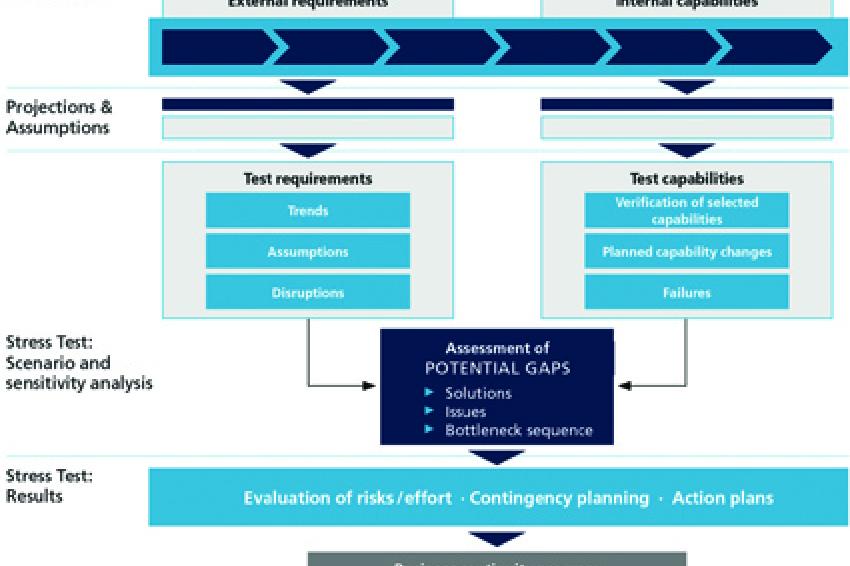Business Agility Is Paramount
Chemical Companies must Ensure their Value Chains are Agile in Volatile Times
Management Strategy - 2012 was a challenging year. But despite the signs of a new economic downturn in several customer industries, the Euro crisis and the increased market volatility, the chemical industry accomplished a rather good business year. Many of the chemical companies were able to increase their revenues. What is the outlook for 2013? The worldwide development for the chemical industry is quite unclear because of the uncertain economic development in major regions and new emerging markets. Leaving stronger signals for an overall downturn behind, recently there is growing indication for economic recovery in China and the US. The European development is still hard to be estimated due to diverse relevance and impact of the debt crisis. In a nutshell: chemical companies worldwide will have to prepare for another volatile year. One of the keys to this challenge is business agility.
Why is Business Agility so Crucial?
The term business agility is coined to express the ability of a company to adapt rapidly and cost efficiently to changes in its business environment. In today's business environment of increased volatility in all kind of factors, a dynamic adaptation is of vital importance to the success of enterprises. The business environment in recent years has been characterized by unpredictable business cycles, caused mainly by the ongoing financial crisis. From the demand side as well as from the cost side, fluctuations have been larger than in the past and also more erratic. Other drivers of volatility are rapid geographic demand shifts caused by demographic developments. Another factor complicating the situation for companies in the chemical industry has been increased globalization with the continuing build-up of highly complex global supply chains. Additionally, political instability in regions deemed as future growth markets for exports or production bases, has heightened the sense of political risk factors. Last but not least, the regular occurrence of natural disasters has shown how vulnerable end market demand or supply chains can be. So there are abundant reasons to question oneself about the adequacy of the current business set-up in order to deal with the above challenges in an efficient way.
How to Assess Business Agility
An evaluation of the agility of the company respective to its business environment should identify the strengths and weaknesses of the current setup and capabilities. A structured approach indicates separate areas of potential improvements. Additionally, a so-called stress test can help to assess how well the company can adapt to various adverse scenarios in its business environment.
Methodology of Agility Assessment
The current business complexity and volatility are identified and mapped. On the basis of this base scenario a first evaluation of the adequacy of the business agility is performed.
The evaluation of internal and external complexities is necessary in order to come to realistic objectives about business agility. It will also give an indication how agility could be increased by reducing complexity. Business agility objectives must be different e.g. for a business that operates interconnected plants in various countries and manages thousands of SKU's and customers interactions from a business with few locations and a less complex product offer. There are different dimensions to be looked at during the assessment, like organizational structure and decision making, production capacities and flexibility, supply chain performance or new product introduction. The analysis of historic volatilities and trends helps to assess how well the company is able to respond to challenges, e.g. it can be measured how a strong, temporary increase in demand was handled and what consequences it had on out of stocks, late deliveries, costs and lost sales, or even lost customers. By looking at past data, a root-cause-analysis is possible that is complemented with interactive workshops.
Agility Stress Test
Based on the results from looking at historic data, in a second step adverse scenarios need to be simulated and the effectiveness of the business response will be assessed. The scenarios will consider assumptions about future development of prices, volatility and regulations as well as potential supply or manufacturing disruptions. The adverse scenarios of the stress test can include e.g.:
- Sharp, temporary drops or increases in demand
- A longer period of increased demand volatility
- A temporary non-delivery by the main one or two raw material suppliers (e.g. by force majeure)
- A temporary shut-down of one, or more, production lines (e.g. by force majeure)
- Strong price increases of the two main, raw materials
- Possible scenarios resulting from regulatory changes in the industry
Some of the above scenarios can be simulated based on the data from the overall assessment, while others need some additional data (e.g. on suppliers' supply chains etc.). These scenarios can also be put to a reality test if doubts about the technical production, or logistical capacities, exist. For a real life simulation, the production of certain critical production lines can be put to the limit to assess real capacities and related variable costs and product quality. Supply chain planning can carry out a mid-term planning exercise on the basis of an assumed plant failure. The evaluation of the estimated business response can then form the input for the development of a focused action plan to increase the agility of the company and create the link to business continuity management.
Stimulating a Dynamic Company Culture
Business agility is paramount to excel in today's fast changing, sometimes unstable, global economy. In its broadest sense, it relates to a company's overall capabilities to adapt quickly to all kinds of external changes. In this article the focus has been placed on supply chain agility.
The many internal, as well as external factors determining business success through agility can be assessed in a structured way. To find the right balance between cost effectiveness and flexibility, it is important to be fact driven. The right balance needs to reflect an actively chosen risk profile that the company wants to adopt. However, there is not always a strong negative correlation between flexibility and cost within a chosen risk profile. Being aware of certain risks and managing them actively does not necessarily carry extra costs. A proactive approach to achieve the right business agility prevents extra costs and increases customer satisfaction. It also stimulates a dynamic company culture that is based on alertness and constant change and which forms a good basis for outperforming competition and long term success
Order the full brochure "Chemical Industry 2013" free of charge at:
www.camelot-mc.com/publications/
Contact
Camelot Management Consultants AG
Theodor-Heuss-Anlage 12
68165 Mannheim
+49 621 86298 0
+49 621 86298 250









